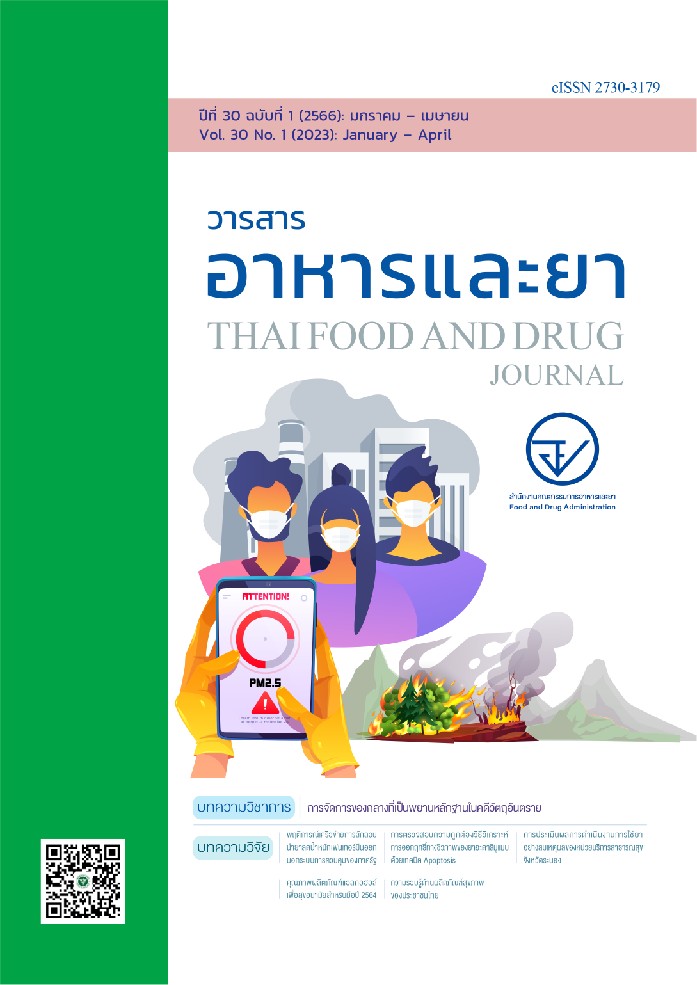ความรอบรู้ด้านผลิตภัณฑ์สุขภาพของประชาชนไทย
Main Article Content
บทคัดย่อ
ความสำคัญ: ปัจจุบันด้วยเทคโนโลยีสื่อสารที่ทำให้ผู้คนสื่อสารได้อย่างอิสระ รวมไปถึงข่าวปลอมเกี่ยวกับผลิตภัณฑ์สุขภาพที่อยู่บนโลกออนไลน์ เหล่านี้ส่งผลอย่างมากต่อความเชื่อและพฤติกรรมสุขภาพ ซึ่งอาจก่อให้เกิดความเชื่อที่ผิด ๆ การขาดความรอบรู้และทักษะในการคัดกรองและเลือกรับผลิตภัณฑ์สุขภาพ จึงอาจนำไปสู่การความเชื่อและพฤติกรรมสุขภาพที่ไม่ถูกต้อง ซึ่งอาจส่งผลต่อไปยังภาวะสุขภาพต่ำ อัตราการตาย อัตราการเข้ารักษาตัวในโรงพยาบาลและค่าใช้จ่ายในการรักษาสูงขึ้นได้ การเพิ่มส่งเสริมความรอบรู้ด้านผลิตภัณฑ์สุขภาพจึงเป็นสิ่งจำเป็น
วัตถุประสงค์: เพื่อประเมินความรอบรู้ด้านผลิตภัณฑ์สุขภาพ และปัจจัยที่มีความสัมพันธ์ต่อความรอบรู้ด้านผลิตภัณฑ์สุขภาพของประชาชนไทยอายุ 15 ปีขึ้นไป
วิธีการวิจัย: การวิจัยเชิงปริมาณ โดยการสำรวจภาคตัดขวางระหว่างเดือนมีนาคม - มิถุนายน 2565 ใช้การสุ่มตัวอย่างแบบแบ่งหลายขั้นตอนจาก 13 เขตสุขภาพทั่วประเทศ โดยการสัมภาษณ์แบบพบตัว (face-to-face interview) ด้วยแบบวัดความรอบรู้ด้านผลิตภัณฑ์สุขภาพ กำหนดจำนวนตัวอย่างไม่น้อยกว่า 2,331 ราย ที่ระดับความเชื่อมั่น ร้อยละ 95 สามารถเก็บตัวอย่างได้ทั้งสิ้น 2,434 ตัวอย่าง
ผลการศึกษา: จากตัวอย่าง 2,434 ราย ส่วนใหญ่เป็นเพศหญิงร้อยละ 57.52 อายุอยู่ระหว่าง 25 - 45 ปี
ร้อยละ 60.44 อาชีพอิสระ ธุรกิจส่วนตัว หรือเกษตรกร ร้อยละ 44.66 การศึกษาระดับปริญญาตรีขึ้นไป
ร้อยละ 42.13 รายได้ 10,000 – 15,000 บาท ร้อยละ 42.19 บทบาทเป็นสมาชิกในชุมชนร้อยละ 90.76 ร่วมกิจกรรมในชุมชนนาน ๆ ครั้งร้อยละ 55.63 และอาศัยในเขตอำเภอเมือง ร้อยละ 68.41 ผลสำรวจคะแนนความรอบรู้ด้านผลิตภัณฑ์สุขภาพเฉลี่ยอยู่ที่ร้อยละ 70.89 โดยอยู่ระดับปานกลาง ร้อยละ 55.88 รองลงมาคือ ระดับมาก ร้อยละ 26.17 และระดับน้อย ร้อยละ 17.95 ตามลำดับ ระดับขั้นความรอบรู้ฯ ที่มีคะแนนมากที่สุดคือขั้นพื้นฐาน ร้อยละ 73.76 รองลงมาเป็นระดับขั้นวิจารณญาณ ร้อยละ 70.95 และขั้นการมีปฏิสัมพันธ์ ร้อยละ 67.01 ตามลำดับ คะแนนความรอบรู้ด้านผลิตภัณฑ์สุขภาพ ตาม V-Shape พบว่าด้านที่คะแนนเฉลี่ยสูงสุดคือ ด้านการปรับเปลี่ยนพฤติกรรม ร้อยละ 75.11 รองลงมาคือ ด้านความเข้าใจ ร้อยละ 75.05 ด้านการเข้าถึงสื่อความรู้ ร้อยละ 72.76 ด้านการบอกต่อ มีส่วนร่วมในสังคม การแบ่งปันข้อมูลที่ได้ ร้อยละ 67.98 ด้านการโต้ตอบ ซักถาม แลกเปลี่ยน ความรู้ ร้อยละ 67.81 และด้านการตัดสินใจ การนึกคิด ทัศนคติ ระดับบุคคล ร้อยละ 66.22 ตามลำดับ โดยปัจจัยที่มีความสัมพันธ์อย่างมีนัยสำคัญทางสถิติกับระดับคะแนนฯ ที่ p<0.05 ประกอบด้วย ปัจจัยภายใน ได้แก่ เพศ การศึกษา อาชีพ รายได้ บทบาทในชุมชน การมีส่วนร่วมในกิจกรรมชุมชน และพื้นที่อยู่อาศัย ปัจจัยภายนอก ได้แก่ การใช้อินเทอร์เน็ต การรับข้อมูล การได้รับและใช้ข้อมูลข่าวสารผลิตภัณฑ์สุขภาพของ อย. ช่องทางสื่อสารข่าวสารที่ประชาชนเลือกใช้สามลำดับแรกคือ เฟซบุ๊ก โทรทัศน์ และยูทูบ ร้อยละ 77.44, 59.04 และ 52.67 ตามลำดับ
สรุป: กลุ่มตัวอย่างส่วนใหญ่มีความรอบรู้ด้านผลิตภัณฑ์สุขภาพอยู่ระดับปานกลาง คือ มีความรอบรู้ดี แต่อาจไม่เพียงพอต่อการปฏิบัติที่ดีได้ถูกต้อง ซึ่งพบว่ากลุ่มตัวอย่างดังกล่าวสามารถค้นหาและเข้าถึงแหล่งข้อมูลได้ด้วยตนเอง และมีพฤติกรรมในการแบ่งปันข้อมูลที่ได้รับกับผู้อื่น แต่ขาดทักษะในการคิดวิเคราะห์ ตัดสินใจ คัดกรอง และคัดเลือกข้อมูลดังกล่าวเพื่อใช้ในการดูแลสุขภาพ (รู้เท่าทันสื่อ) โดยมีทั้งปัจจัยภายในและภายนอกที่เกี่ยวกับการรับสื่อสังคมต่าง ๆ ยังเป็นปัจจัยที่ส่งผลต่อระดับความรอบรู้ฯ อย่างมีนัยสำคัญทางสถิติด้วย
Article Details

อนุญาตภายใต้เงื่อนไข Creative Commons Attribution 4.0 International License.
เอกสารอ้างอิง
อรรถเกียรติ กาญจนพิบูลวงศ์, ภานุวัฒน์ คำวังสง่า, สุธิดา แก้วทา. รายงานสถานการณ์โรค NCDs เบาหวาน ความดันโลหิตสูง และปัจจัยเสี่ยงที่เกี่ยวข้อง พ.ศ. 2562. นนทบุรี: อักษรกราฟฟิคแอนด์ดีไซน์; 2563.
แสงเดือน ผ่องพุฒ. สื่อสังคมออนไลน์ : แนวทางการนำมาประยุกต์ใช้ (Social media : How to application). บทความวิชาการ [อินเทอร์เน็ต]. 2556 [เข้าถึงเมื่อ 1 ส.ค. 2563]; 3(20): 1-18. เข้าถึงได้จาก : https://library.senate.go.th/document/Ext6685/6685991_0004.PDF
สำนักงานกองทุนสนับสนุนการสร้างเสริมสุขภาพ. สำนักพัฒนาภาคีสัมพันธ์และวิเทศสัมพันธ์. ชัวร์หรือมั่ว เชื่อได้หรือไม่ (Fake News สุขภาพ). จับตาทิศทางสุขภาพคนไทย ปี 2563 (Thai health watch 2020).กรุงเทพฯ: สำนักพัฒนาภาคีสัมพันธ์และวิเทศสัมพันธ์ สำนักงานกองทุนสนับสนุนการสร้างเสริมสุขภาพ; 2563.
World Health Organization. Health promotion glossary [Internet]. Geneva: Division of Health Promotion, Education and Communications, Health Education and Health Promotion Unit, WHO; 1998 [cited 2020 Aug 1]. Available from: https://www.who.int/healthpromotion/about/HPR%20Glossary%201998.pdf
วิมล โรมา, สายชน คล้องเอี่ยม, วรัญญา สุขวงศ์, ฐิติวัฒน์ แก้วอำดี, อัจฉรา ตันหนึ่ง, รุ่งนภา คำผาง, และคณะ.การสำรวจความรอบรู้ด้านสุขภาพของประชาชนไทย อายุ 15 ปี ขึ้นไป พ.ศ. 2562. นนทบุรี: สถาบันวิจัยระบบสาธารณสุข; 2562.
วิมล โรมา, ชะนวนทอง ธนสุกาญจน์, มธุรส ทิพยมงคลกุล, ณัฐนารี เอมยงค์, นรีมาลย์ นีละไพจิตร, สายชล คล้อยเอี่ยม, และคณะ. การสำรวจความรอบรู้ด้านสุขภาพของประชาชนไทย อายุ 15 ปี ขึ้นไป พ.ศ. 2560 (ระยะที่ 1). นนทบุรี: สถาบันวิจัยระบบสาธารณสุข; 2560.
Parker RM, et al. The test of functional health literacy in adults: a new instrument for measuring patients’ literacy skills. J Gen Intern Med. [cited 2020 Aug 1]1995 Oct;10 (10):537-41. doi.org/10.1007/BF02640361.
Norman CD, Skinner HA. eHealth literacy: essential skills for consumer health in a networked world. J Med Internet Res. 2006 Jun 16;8(2): e9. doi: 10.2196/jmir.8.2.e9.
Davis TC, Long SW, Jackson RH, et al. Rapid estimate of adult literacy in medicine: a shortened screening instrument. Fam Med. 1993;25(6):391-395. PubMed PMID: 8349060
Ishikawa H, Nomura K, Sato M, Yano E. Developing a measure of communicative and critical health literacy: a pilot study of Japanese office workers. Health Promot Int. 2008 Sep;23(3):269-74. doi: 10.1093/heapro/dan017.
อังศินันท์ อินทรกำแหง. การพัฒนาเครื่องมือความรอบรู้ด้านสุขภาพของคนไทย. นนทบุรี: กองสุขศึกษา กรมสนับสนุนบริการสุขภาพ กระทรวงสาธารณสุข; 2560.
Nutbeam D. Health literacy as a public health goal: a challenge for contemporary health education and communication strategies into health 21st century. Health Promotion International 2000;15(3):259-67. https://doi.org/10.1093/heapro/15.3.259.
Osborne RH, Batterham RW, Elsworth GR, Hawkins M, Buchbinder R. The grounded psychometric development and initial validation of the health literacy questionnaire (HLQ). BMC Public Health 2013;13:658. doi:10.1186/1471-2458-13-658.
Bloom BS. Handbook on formative and Summative Evaluation of Student Learning. New York: McGraw-Hill Book, 1971.
กฤษณี เกิดศรี, สงวน ลือเกียรติบัณฑิต. ความสัมพันธ์ระหว่างความแตกฉานด้านสุขภาพกับความสามารถในการคุ้มครองตนเองของผู้บริโภคในเรื่องผลิตภัณฑ์สุขภาพ. วารสารเภสัชกรรมไทย 2561;10(1):239-48.
ภมร ดรุณ, ประกันชัย ไกรรัตน์. ปัจจัยความรอบรู้ด้านสุขภาพที่มีอิทธิพลต่อพฤติกรรมสุขภาพของประชาชนจังหวัดบึงกาฬ. วารสารวิชาการกรมสนับสนุนบริการสุขภาพ 2562;15(3):71-82.


